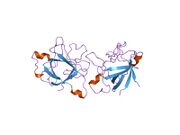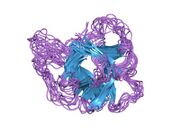Biology:Interleukin 1 receptor antagonist
 Generic protein structure example |
The interleukin-1 receptor antagonist (IL-1RA) is a protein that in humans is encoded by the IL1RN gene.[1][2]
IL-1RA was initially called the IL-1 inhibitor and was discovered separately in 1984 by two independent laboratories.[3] IL-1RA is an agent that binds non-productively to the cell surface interleukin-1 receptor (IL-1R), the same receptor that binds interleukin 1 family (IL-1), preventing IL-1's from sending a signal to that cell.
Function
IL-1RA is a member of the interleukin 1 cytokine family. IL1Ra is secreted by various types of cells including immune cells, epithelial cells, and adipocytes, and is a natural inhibitor of the pro-inflammatory effect of IL1β.[4] This protein inhibits the activities of interleukin 1, alpha (IL1A) and interleukin 1, beta (IL1B), and modulates a variety of interleukin 1 related immune and inflammatory responses. This gene and five other closely related cytokine genes form a gene cluster spanning approximately 400 kb on chromosome 2. Four alternatively spliced transcript variants encoding distinct isoforms have been reported.[5]
Clinical significance
A polymorphism of this gene is reported to be associated with increased risk of osteoporotic fractures[6] and gastric cancer.[7]
Mutations in the IL1RN gene results in a rare disease called deficiency of the interleukin-1–receptor antagonist (DIRA).[8] Variants of the IL1RN gene is also associated with risk of schizophrenia.[9][10] Elevated levels of IL1RN has been found in serum of schizophrenia patients.[11]
A recombinant, slightly modified version of interleukin 1 receptor antagonist called anakinra is used in the treatment of rheumatoid arthritis, an autoimmune disease in which IL-1 plays a key role.[12] Anakinra differs from native human IL-1Ra in that it has the addition of a single methionine residue at its amino terminus [13]
Use in horses
Interleukin 1 receptor antagonist is used in horses for the treatment of equine lameness secondary to joint and soft-tissue injury.
References
- ↑ "The human IL-1 receptor antagonist gene (IL1RN) maps to chromosome 2q14-q21, in the region of the IL-1 alpha and IL-1 beta loci". Genomics 13 (3): 654–7. July 1992. doi:10.1016/0888-7543(92)90137-H. PMID 1386337.
- ↑ "The human interleukin-1 receptor antagonist (IL1RN) gene is located in the chromosome 2q14 region". Genomics 15 (1): 173–6. January 1993. doi:10.1006/geno.1993.1025. PMID 8432529.
- ↑ Dinarello CA (December 1994). "The interleukin-1 family: 10 years of discovery". FASEB J. 8 (15): 1314–25. doi:10.1096/fasebj.8.15.8001745. PMID 8001745.
- ↑ "IL-1 receptor antagonist in metabolic diseases: Dr Jekyll or Mr Hyde?". FEBS Lett. 580 (27): 6289–94. November 2006. doi:10.1016/j.febslet.2006.10.061. PMID 17097645.
- ↑ "Entrez Gene: IL1RN interleukin 1 receptor antagonist". https://www.ncbi.nlm.nih.gov/sites/entrez?Db=gene&Cmd=ShowDetailView&TermToSearch=3557.
- ↑ "Osteoporotic fractures are associated with an 86-base pair repeat polymorphism in the interleukin-1--receptor antagonist gene but not with polymorphisms in the interleukin-1beta gene". J. Bone Miner. Res. 15 (3): 402–14. March 2000. doi:10.1359/jbmr.2000.15.3.402. PMID 10750554.
- ↑ "Interleukin-1 polymorphisms associated with increased risk of gastric cancer". Nature 404 (6776): 398–402. March 2000. doi:10.1038/35006081. PMID 10746728. http://digitalcommons.unl.edu/cgi/viewcontent.cgi?article=1131&context=publichealthresources.
- ↑ "An Autoinflammatory Disease with Deficiency of the Interleukin-1–Receptor Antagonist". N. Engl. J. Med. 360 (23): 2426–37. June 2009. doi:10.1056/NEJMoa0807865. PMID 19494218.
- ↑ "Impact of IL-1 receptor antagonist gene polymorphism on schizophrenia and bipolar disorder". Psychiatr. Genet. 14 (3): 165–7. September 2004. doi:10.1097/00041444-200409000-00009. PMID 15318032.
- ↑ "Association between IL-1beta -511C/T and IL-1RA (86bp)n repeats polymorphisms and schizophrenia". J Psychiatr Res 37 (6): 457–62. 2003. doi:10.1016/S0022-3956(03)00072-4. PMID 14563376.
- ↑ "Similar immune profile in bipolar disorder and schizophrenia: selective increase in soluble tumor necrosis factor receptor I and von Willebrand factor". Bipolar Disord 11 (7): 726–34. November 2009. doi:10.1111/j.1399-5618.2009.00757.x. PMID 19839997.
- ↑ "Anakinra for rheumatoid arthritis". The Cochrane Database of Systematic Reviews (1): CD005121. January 2009. doi:10.1002/14651858.CD005121.pub3. PMID 19160248.
- ↑ "Kineret (anakinra) injection, for subcutaneous use". Swedish Orphan Biovitrum. http://www.kineretrx.com/pdf/Full-Prescribing-Information-English.pdf.
Further reading
- "Interleukin-1 receptor antagonist: role in biology". Annu. Rev. Immunol. 16: 27–55. 1998. doi:10.1146/annurev.immunol.16.1.27. PMID 9597123.
- "Molecular mechanisms of corticosteroid actions". Monaldi Archives for Chest Disease 55 (3): 256–66. 2000. PMID 10948677.
- Arend WP (2003). "The balance between IL-1 and IL-1Ra in disease". Cytokine Growth Factor Rev. 13 (4–5): 323–40. doi:10.1016/S1359-6101(02)00020-5. PMID 12220547.
- "Polymorphism of IL-1 receptor antagonist gene: role in cancer". Anticancer Res. 22 (6A): 3421–4. 2003. PMID 12530098.
- "Interleukin-1B polymorphisms and gastric cancer risk--a meta-analysis". Cancer Epidemiol. Biomarkers Prev. 15 (10): 1920–8. 2007. doi:10.1158/1055-9965.EPI-06-0267. PMID 17035400.
External links
- Interleukin+1+Receptor+Antagonist+Protein at the US National Library of Medicine Medical Subject Headings (MeSH)




